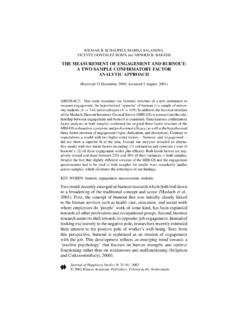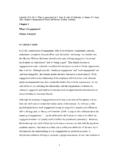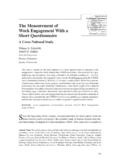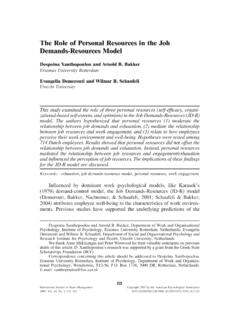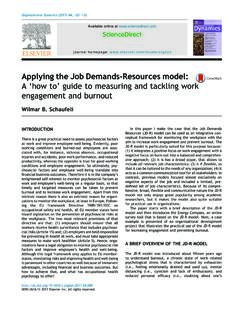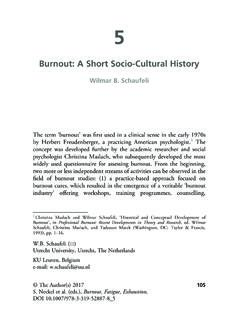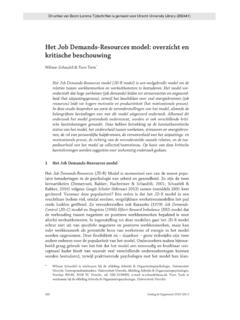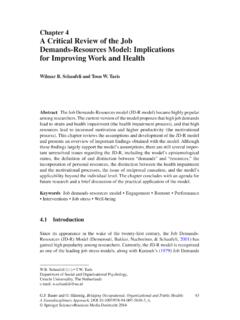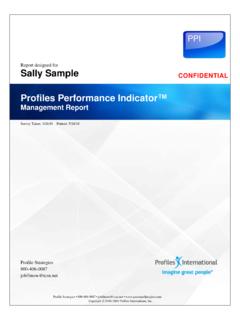Transcription of UWES - wilmarschaufeli.nl
1 UWES UTRECHT WORK ENGAGEMENT SCALE Preliminary Manual [Version , December 2004] Wilmar Schaufeli & Arnold Bakker Occupational Health Psychology Unit Utrecht University Contents Page 1. The concept of work engagement .. 4 2. Development of the UWES .. 6 3. Validity of the UWES ..8 4. Psychometric quality of the Dutch version .. 11 Description of the Dutch language 11 Distribution characteristics of the 13 Internal 14 Factor structure and 15 Relationships with 17 Relationships with age and 18 Differences between occupational Shortened Student 5. Other language 23 Description of the international language 24 Distribution characteristics of the.
2 26 .. 26 Factor structure and .. 28 Relationships with age and 30 Differences between .. 31 Shortened 32 6. Practical Completion and Dutch 33 Other language 37 7. 41 References Appendix: UWES versions UWES Manual; page 3 Preface Contrary to what its name suggests, Occupational Health Psychology has almost exclusive been concerned with ill-health and unwell-being. For instance, a simple count reveals that about 95% of all articles that have been published so far in the Journal of Occupational Health Psychology deals with negative aspects of workers' health and well-being , such as cardiovascular disease, Repetitive Strain Injury, and burnout. In contrast, only about 5% of the articles deals with positive aspects such as job satisfaction and motivation.
3 This rather one-sided negative focus is by no means specific for the field of occupational health psychology. According to a recent estimate, the amount of psychological articles on negative states outnumbers the amount of positive articles by 17 to 11. However, it seems that times have changed. Since the beginning of this century, more attention is paid to what has been coined positive psychology: the scientific study of human strength and optimal functioning. This approach is considered to supplement the traditional focus of psychology on psychopathology, disease, illness, disturbance, and malfunctioning. The recent trend to concentrate on optimal functional also aroused attention in organizational psychology, as is demonstrated by a recent plea for positive organizational behavior; that is.
4 The study of positively oriented human resource strengths and psychological capacities that can be measured, developed, and effectively managed for performance improvement in today s workplace 2. Because of the emergence of positive (organizational) psychology, it is not surprising that positive aspects of health and well-being are increasingly popular in Occupational Health Psychology. One of these positive aspects is work engagement, which is considered to be the antipode of burnout. Whilst burned-out workers feel exhausted and cynical, their engaged counterparts feel vigorous and enthusiastic about their work. In contrast to previous positive approaches such as the humanistic psychology who were largely unempirical, the current positive psychology is empirical in nature. This implies the careful operationalization of constructs, including work engagement.
5 Hence, we wrote this test-manual of the Utrecht Work Engagement Scale (UWES). This test manual is preliminary, which means that our work on the UWES is still in progress. Nevertheless, we did not want to wait any longer with publishing some important psychometric details since many colleagues, both in The Netherlands as well as abroad, are working with the UWES. Many of them have contributed to this preliminary test-manual by proving us with their data. Without their help this manual could not have been written. Therefore, we would like to thank our colleagues for their gesture of true scientific collaboration3. Utrecht/Val ncia, November 2003 1 Diener, E., Suh, , Lucas, & Smith, (1999). Subjective well-being: Three decades of progress. Psychological Bulletin, 125, 267-302.
6 2 Luthans, F. (2002). The need for and meaning of positive organizational behavior. Journal of Organizational Behavior, 23, 695-706. 3 Sarah Jane Cotton (AUS), Edgar Bresco (SPA), Maureen Dollard (AUS), Esther Greenglass (CAN), Asbj rn Grimsmo (NOR), Gabriele Haeslich (GER), Jari Hakanen (FIN), Sandrine Hollet (FRA), Aristotelis Kantas (GRE), Alexandra Marques Pinto (POR), Stig Berge Matthiesen (NOR), Susana Llorens (SPA), Astrid Richardsen (NOR), Peter Richter (GER), Ian Rothmann (SAF), Katariina Salmela-Aro (FIN), Marisa Salanova (SPA), Sabine Sonnentag (GER), Peter Vlerick (BEL), Tony Winefield (AUS), Hans de Witte (BEL), Dieter Zapf (GER). UWES Manual; page 4 1. The concept of work engagement Work engagement is the assumed opposite of burnout. Contrary to those who suffer from burnout, engaged employees have a sense of energetic and effective connection with their work activities and they see themselves as able to deal well with the demands of their job.
7 Two schools of thought exist on the relationship between work engagement and burnout. The first approach of Maslach and Leiter (1997) assumes that engagement and burnout constitute the opposite poles of a continuum of work related well-being, with burnout representing the negative pole and engagement the positive pole. Because Maslach and Leiter (1997) define burnout in terms of exhaustion, cynicism and reduced professional efficacy, it follows that engagement is characterized by energy, involvement and efficacy. By definition, these three aspects of engagement constitute the opposites of the three corresponding aspects of burnout. In other words, according to Maslach and Leiter (1997) the opposite scoring pattern on the three aspects of burnout as measured with the Maslach Burnout Inventory (MBI; Maslach, Jackson & Leiter, 1996) implies work engagement.
8 This means that low scores on the exhaustion- and cynicism-scales and a high score on the professional efficacy scale of the MBI is indicative of engagement. However, the fact that burnout and engagement are assessed by the same questionnaire has at least two important negative consequences. First, it is not plausible to expect that both concepts are perfectly negatively correlated. That is, when an employee is not burned-out, this doesn t necessarily mean that he or she is engaged in his or her work. Reversibly, when an employee is low on engagement, this does not mean that he or she is burned-out. Secondly, the relationship between both constructs cannot be empirically studied when they are measured with the same questionnaire. Thus, for instance, both concepts cannot be included simultaneously in one model in order to study their concurrent validity.
9 For this reason we define burnout and work engagement are two distinct concepts that should be assessed independently (Schaufeli & Bakker, 2001). Although employees will experience work engagement and burnout as being opposite psychological states, whereby the former has a positive quality and the latter a negative quality, both need to be considered as principally independent of each other. This means that, at least theoretically, an employee who is not burned-out may score high or low on engagement, whereas an engaged employee may score high or low on burnout. In practice, however, it is likely that burnout and engagement are substantively negatively correlated. In contrast to Maslach and Leiter s (1997) approach, our approach enables the assessment of the strength of the association between work engagement and burnout since different instruments assess both independently.
10 It is possible to include both constructs simultaneously in one analysis, for instance, to investigate whether burnout or engagement explains additional unique variance in a particular variable after the opposite variable has been controlled for. Work engagement is defined as follows (see also Schaufeli, Salanova, Gonz lez-Rom & Bakker, 2001): Engagement is a positive, fulfilling, work-related state of mind that is characterized by vigor, dedication, and absorption. Rather than a momentary and specific state, engagement refers to a more persistent and pervasive affective-cognitive state that is not focused on any particular UWES Manual; page 5 object, event, individual, or behavior. Vigor is characterized by high levels of energy and mental resilience while working, the willingness to invest effort in one s work, and persistence even in the face of difficulties.
